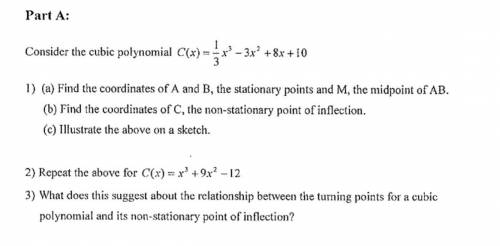Part A:
Consider the cubic polynomial C(x) =*#* -38° +8x+10
1) (a) Find the coordinates of A...

Mathematics, 24.09.2021 15:50, OnlyaBurden
Part A:
Consider the cubic polynomial C(x) =*#* -38° +8x+10
1) (a) Find the coordinates of A and B, the stationary points and M, the midpoint of AB.
(b) Find the coordinates of C, the non-stationary point of inflection.
(©) Illustrate the above on a sketch.
2) Repeat the above for C(x) = x2 -1.9.x2 - 12
3) What does this suggest about the relationship between the turning points for a cubic
polynomial and its non-stationary point of inflection?


Answers: 3
Other questions on the subject: Mathematics




Mathematics, 22.06.2019 02:40, liyahheadhigh
Benefit(s) from large economies of scale, in which the costs of goods decrease as output increases. natural monopolles perfect competition
Answers: 1
Do you know the correct answer?
Questions in other subjects:



Mathematics, 17.03.2020 22:09


Mathematics, 17.03.2020 22:09

Geography, 17.03.2020 22:09

Mathematics, 17.03.2020 22:09

Mathematics, 17.03.2020 22:09

Mathematics, 17.03.2020 22:09

Chemistry, 17.03.2020 22:09






